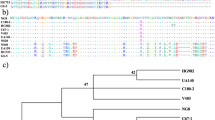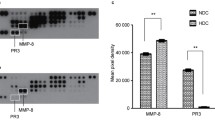Abstract
Periodontitis is associated with the presence of certain Gram-negative bacteria in the oral cavity, among these Actinobacillus actinomycetemcomitans. In order to determine which types of salivary components interact with A. actinomycetemcomitans two strains (HG 1175 and FDC Y4) were incubated with whole saliva and individual glandular secretions, viz. parotid, submandibular, and sublingual saliva. Immunochemical analysis by immunoblotting of bacteria-bound salivary proteins showed that IgA, the low-molecular mucin MG2, parotid agglutinin, and a 300 kDa sublingual and submandibular glycoprotein, were bound to the bacterial strains tested. In addition, adherence of A. actinomycetemcomitans to salivary proteins in a solid-phase was studied. After electrophoresis and transfer of salivary proteins to nitrocellulose membranes A. actinomycetemcomitans adhered only to MG2. In this assay periodate treatment, mild acid hydrolysis or neuraminidase digestion of the saliva glycoproteins abolished binding of two clinical isolates (HG 1175 and NY 664), suggesting that sialic acid residues on MG2 are involved in the binding. In contrast, adherence of the smooth laboratory strain Y4 was not affected by removal of sialic acid residues or even periodate treatment of MG2.
Similar content being viewed by others
Abbreviations
- S-IgA:
-
Secretory IgA
- MG1:
-
high-molecular-weight mucin
- MG2:
-
low-molecular-weight mucin
- EP-GP:
-
extra parotid-glycoprotein
- PRPs:
-
proline-rich proteins
- SNA:
-
Sambucus nigra agglutinin
- MAA:
-
Maackia amurensis agglutinin
- PNA:
-
peanut agglutinin
- UEA:
-
Ulex europaeus agglutinin
References
Al-Hashimi I & Levine MJ (1989) Characterization of in vivo salivary-derived enamel pellicle. Arch. Oral Biol. 34:289–295
Biesbrock AR, Reddy MS & Levine MJ (1991) Interaction of a salivary mucin-secretory immunoglobulin A complex with mucosal pathogen. Infect. Immun. 59:3492–3497
Brandtzaeg P, Fjellanger I, & Gjeruldsen ST (1968) Adsorption of immunoglobulin A onto oral bacteria in vivo. J Bacteriol. 96: 24–29
Bratthall D & Carlen A (1978) Salivary agglutinin and secretory IgA reactions with oral streptococci. Scand. J. Dent. Res. 86:430–443
Braun W & Abraham R (1989) Modified diffusion blotting for rapid and efficient protein transfer with Phastsystem. Electrophoresis 10:249–253
Ebisu E, Fukuhara H & Okada H (1988) Purification and characterization of Eikenella corrodens aggregating factor from human submandibular-sublingual saliva. J. Periodont. Res. 23:328–333
Engström P-E, Larsson A, Norhagen EG, Smith CIE, Sällberg M, Helgeland K & Hammarström L (1993) Specificity and levels of oral and systemic antibodies to Actinobacillus actinomycetem-comitans. J. Clin. Periodontol. 20:746–751
Fisher SJ, Prakobphol A, Kajisa L & Murray PA (1987) External radiolabeling of components of pellicle on human enamel and cementum. Arch. Oral Biol. 32:509–517
Göbons RJ, Hay DI, Childs III WC & Davis G (1990) Role of cryptic receptors (cryptitopes) in bacterial adhesion to oral surfaces. Arch. Oral Biol. 35 (suppl):107s-114s
Gillece-Castro BL, Prakobphol A, Burlingame AC, Leffener H & Fisher SJ (1991) Structure and bacterial receptor activity of a human salivary proline-rich glycoprotein. J. Biol. Chem. 266:17358–17368
Gmür R & Guggenheim B (1990) Monoclonal antibodies for the detection of ‘periodontopathic’ bacteria. Arch. Oral Biol. 35 (suppl):145s-151s
Henskens YMC, Veerman ECI, Mantel MS, Van der Velden U & Nieuw Amerongen AV (1994) Cystatins S and C in human whole saliva and in glandular salivas in periodontal health and disease. J. Dent. Res. 73: 1606–1614
Hoffman MP & Haidaris CG (1993) Analysis of Candida albicans adhesion to salivary mucin. Infect. Immun. 61:1940–1949
Kagermeier AS & London J (1985) Actinobacillus actinomycetemcomitans Y4 and N27 adhere to hydroxyapatite by distinctive mechanisms. Infect. Immun. 47:854–858
Kishimoto E, Hay DI and Gibbons RJ (1989) A human salivary protein which promotes adhesion of Streptoccocus mutans c strains to hydroxyapatite. Infect. Immun. 57:3702–3707
Levine MJ, Tabak LA, Reddy M & Mandel ID (1985) Nature of salivary pellicles in microbial adherence: Role of salivary mucins. In: Mergenhagen SE & Rosan B (eds.) Molecular basics of oral microbial adhesion (pp 125–130). American Society for Microbiology, Washington DC
Levine MJ, Reddy MS, Tabak LA, Loomis RE, Bergey EJ, Cohen RE, Stinson MW & Al-Hashimi I (1987) Structural aspects of salivary glycoproteins. J. Dent. Res. 66:436–441
Ligtenberg AJM, Walgreen-Weterings E, Veerman ECI, De Soet JJ, De Graaff J & Nieuw Amerongen AV (1992) Influence of saliva on aggregation and adherence of Streptococcus gordonii HG 222. Infect. Immun. 60:3878–3884
Ligenberg AJM, Walgreen-Weterings E, Veerman ECI, De Graaff J & Nieuw Amerongen AV (1993) Adherence of Streptococcus gordonii HG 222 in the presence of saliva. Antonie van Leeuwenhoek 64:39–45
Liljemark WF, Bloomquist CG & Ofstehage JC (1979) Aggregation and adherence of Streptococcus sanguis: Role of human salivary immunoglobulin A. Infect. Immun. 26:1104–1110
Mintz KP & Fives-Taylor PM (1994) Adhesion of Actinobacillus actinomycetemcomitans to a human oral cell line. Infect. Immun. 62:3672–3678
Nakagawa S, Machida Y, Nakagawa T, Fujii H, Yamada S, Takazoe I & Okuda K (1994) Infection by Porphyromonas gingivalis and Actinobacillus actinomycetemcomitans and antibody response at different ages in humans. J. Periodont. Res. 29:9–16
Nieuw Amerongen AV, Strooker H, Oderkerk CH, Bank RA, Henskens YMC, Schenkels LCPM, Ligtenberg AJM, & Veerman ECI (1992) Changes in saliva of epileptic patients. J. Oral Pathol. Med. 21:203–208
Ofek I & Perry A (1985) Molecular basis of bacterial adherence to tissues. In: Mergenhagen SE & Rosan B (eds.) Molecular basics of oral microbial adhesion (pp 7–13). American Society for Microbiology, Washington DC
Pertsch MJ & Glickman I (1967) Salivary neuraminidase. III. Its relation to oral disease. J. Periodont. Res. 38:189–192
Prakobphol A, Murray PA & Fisher SJ (1987) Bacterial adherence on replicas of sodium dodecyl sulphate-polyacrylamide gels. Anal. Biochem. 164:5–11
Rathman WM, Van Zeyl MJ, Van den Keybus PAM, Bank RA, Veerman ECI & Nieuw Amerongen AV (1990) Charactenzation of monoclonal antibodies to human salivary (glyco)proteins. Cellular localization of mucin, cystatin-like 14 kD protein and 20 kD glycoprotein in the human submandibular gland. J. Biol. Buccale 18:19–27
Rundegren J (1986) Calcium-dependent salivary agglutinin with reactivity to various oral bacterial species. Infect. Immun. 53:173–178
Sandholm L, Tolo K & Olsen I (1987) Salivary IgG, a parameter of periodontal disease activity? High responders to Actinobacillus actinomycetemcomitans Y4 in juvenile and adult periodontitis. J. Clin. Periodontol. 14:289–294
Saxén L, Tenovuo J & Vilja P (1990) Salivary defense mechanisms in juvenile periodontitis. Acta Odontol. Scand. 48:399–407
Scannapieco FA, Bergey EJ, Reddy MS & Levine MJ (1989) Characterization of salivary α-amylase binding to Streptococcus sanguis. Infect. Immun. 57:2853–2863
Schenkels LCPM, Ligtenberg AJM, Veerman ECI & Nieuw Amerongen AV (1993) Interaction of the salivary glycoprotein EP-GP with the bacterium Streptococcus salivarius HB. J. Dent. Res. 72:1559–1565
Schneyer LH (1955) Method for the collection of separate submaxillary and sublingual salivas in man. J. Dent. Res. 34:257–261
Shibata S, Nagata K, Nakumura R, Tsunemitsu A & Misaki A (1980) Interaction of parotid saliva basic glycoprotein with Streptococcus sanguis ATCC 10557. J. Periodontol. 51:499–504
Slots J & Listgarten MA (1988) Bacteroides gingivalis, Bacteroides intermedius, and Actinobacillus actinomycetemcomitans in human periodontal diseases. J. Clin. Periodontol. 15:85–93
Stinson MW, Levine MJ, Cavese JM, Prakobphol A, Murray PA, Tabak LA & Reddy MS (1982) Adherence of Streptococcus sanguis to salivary mucin bound to glass. J. Dent. Res. 61:1390–1393
Tabak LA, Levine MJ, Mandel ID & Ellison SA (1982) Role of salivary mucins in the protection of the oral cavity. J. Oral Pathol. 11:1–17
Takano K, Malamud D & Hand AR (1992) Differential distribution of a carbohydrate epitope (Y) on human salivary gland cell membranes. Okajimas Folia Anat. Jpn. 69(5):225–238
Van Seuningen I & Davril M (1992) A rapid periodic acid-Schiff staining procedure for the detection of glycoproteins using the PhastSystem. Electrophoresis 13:97–99
Van Winkelhoff AJ & De Graaff J (1991) Microbiology in the management of destructive periodontal disease. J. Clin. Periodontol. 18:406–410
Veerman ECI, Valentijn-Benz M & Nieuw Amerongen AV (1989) Viscosity of human salivary mucins: effect of pH and ionic strength and role of sialic acid. J. Biol. Bucale, 17:297–306
Veerman ECI, Valentijn-Benz M, Van den Keybus PAM, Rathman WM, Sheehan JK & Nieuw Amerongen AV (1991) Immunochemical analysis of high molecular-weight human salivary mucins (MG1) using monoclonal antibodies. Arch. Oral Biol. 36:923–932
Veerman ECI, Ligtenberg AJM, Schenkels LCPM, Walgreen-Weterings E & Nieuw Amerongen AV (1995) Binding of human high-molecular-weight salivary mucins (MG1) to Hemophilus parainfluenzae. J. Dent. Res. 74:351–357
Williams RC & Gibbons RJ (1972) Inhibition of bacterial adherence by secretory immunoglobulin A: a mechanism of antigen disposal. Science 177:697–699
Woodward MP, Young WW Jr & Bloodgood RA (1984) Detection of monoclonal antibodies specific for carbohydrate epitopes using periodate oxidation. J. Immun. Meth. 78:143–153
Zambon JJ (1985) Actinobacillus actinomycetemcomitans in human periodontal disease. J. Clin. Periodont. 12:1–20
Author information
Authors and Affiliations
Rights and permissions
About this article
Cite this article
Groenink, J., Ligtenberg, A.J.M., Veerman, E.C.I. et al. Interaction of the salivary low-molecular-weight mucin (MG2) with Actinobacillus actinomycetemcomitans . Antonie van Leeuwenhoek 70, 79–87 (1996). https://doi.org/10.1007/BF00393572
Received:
Accepted:
Issue Date:
DOI: https://doi.org/10.1007/BF00393572




